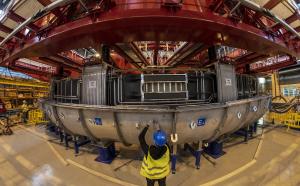Into the cold chamber
Before they can be considered fit for service, the ring-shaped coils that circle the ITER vacuum vessel must be submitted to a series of tests designed to confirm their performance in the daunting environment of a burning plasma. The procedure begins with the delicate insertion of the coil inside a close-fitting, doughnut-shaped cryostat and extends more than one month.
Whether performed at room temperature or at 80 K (minus 194 degrees Celsius), the tests aim to verify the helium cooling circuit's leak-tightness, the performance of the electrical insulation and the coil's mechanical behaviour under cryogenic conditions. Although cold tests have been performed before (on PF6 in December 2020, on PF5 in March 2021 and on PF2 in October 2021), the operation that began on Monday 20 February 2023 in the European poloidal field coil facility on site was exceptionally spectacular: PF4, the coil that was inserted into the open cryostat, is 24 metres in diameter and weighs in excess of 350 tonnes.
Moving such a delicate and massive component requires an equally delicate and massive lifting tool. The gantry crane in Europe's poloidal field coil facility—a 30-metre-in-diameter steel structure supported by four hydraulic towers traveling on rails—meets these requirements. Equipped with hydraulic slings and load sensors, it is capable of moving a large circular coil while ensuring at all times a uniform distribution of the load. (Click here to view a short time-lapse video of the coil lifting and insertion.)
"As the gantry crane can only move along the rails in the longitudinal direction it is of the utmost importance that the cryostat be installed in the correct coordinates," explains Mónica Martínez, the European Domestic Agency's (F4E's) Technical Officer for poloidal field coils. Aligning the crane's laser pointer to a simple point marked on the building's floor does the trick: the coil can be gently lowered into the cryostat where it will spend more than one month, experiencing extreme cold, intense pressure, high voltage and considerable thermal stresses—a foretaste of its life to come.
See the report on the Fusion for Energy website.



